Wedding Rings
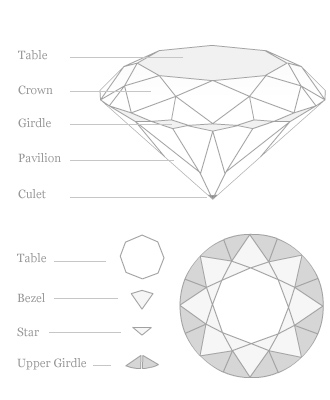
Diamond Cut
The cut of a diamond not only refers to the diamond’s shape, it also refers to how effectively the diamond returns light back to the viewer’s eye. A well-cut diamond will appear very brilliant and fiery, while a poorly cut diamond can appear dark and lifeless, regardless of its color or clarity.
Not only do well-cut diamonds appear more brilliant, they also tend to appear larger than other diamonds of the same carat weight. An "ideal" diamond has both increased brilliance and diameter relative to more deeply-cut diamonds.
Ideal cut diamonds
An Ideal Cut Diamond is a round, brilliant, or princess cut diamond that is cut to ideal proportions and angles, and has excellent polish and symmetry ratings. An Ideal Cut Diamond is perfectly proportioned to refract light, producing that fire and brilliance up through to the table and crown. James Allen offers a nice selection of Ideal Cut Diamonds know at True HeartsTM
Hearts and Arrows True HeartsTM
Seen from above, a Hearts and Arrows diamond shows an arrow pattern. When displayed on its pavilion side, the diamond presents the eye with 8 hearts with tiny 'v' shapes. Genuine Hearts and Arrows have these patterns visible at a single glance, indicating that the diamond has perfect optical symmetry.
Our Hearts and Arrows collection are the ultimate expression of love - that's why we call them TrueHeartsTM. Every diamond from our TrueHeartsTM collection is a lasting masterpiece, a perfect diamond.
Hearts and Arrows diamonds are sold under many names - Hearts on Fire and Leo Diamonds are two popular examples. At James Allen, we take pride in presenting only the finest Hearts and Arrows diamonds money can buy - every single TrueHeartsTM diamond we sell is cut and polished at 100X magnification. Furthermore, our exclusive Diamond Display TechnologyTM lets you see any True HeartsTM diamond magnified in 360° so you can see exactly what you are getting.
Understanding Brilliance, Dispersion & Scintillation
A well-cut diamonds exhibit three different properties: brilliance, dispersion and scintillation. As light strikes a diamond's surface, it will either reflect off the table of a polished stone or enter the diamond. The light that is reflected off the diamond is known as the diamond's brilliance. As light travels through a stone, some of the light rays are separated into flashes of color. This is known as dispersion. The result of dispersion—the separation of white light into its spectral colors— is known as fire. Scintillation is flashes of color that are viewable as an observer moves a diamond back and forth.
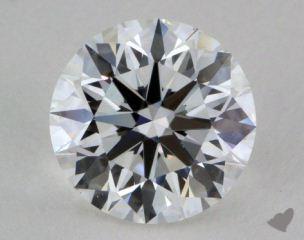

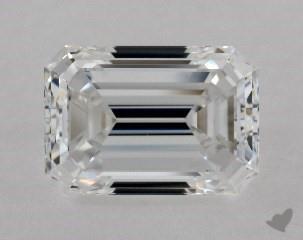

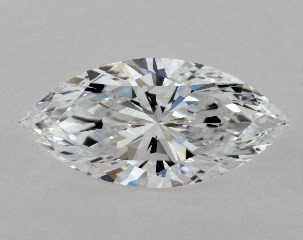
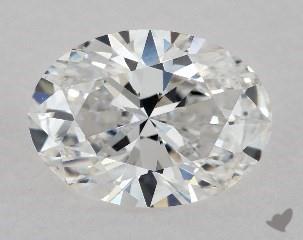



Diamond Shapes
Diamonds come in many different shapes. Each diamond shape possesses its own unique qualities, so exploring and learning about the various shapes is worth your while. James Allen offers the highest quality certified diamonds to satisfy all tastes.
Asscher Cut Diamonds
The Asscher Cut Diamond, also called a "Square Emerald-Cut", is made using a step-cut process and has cropped corners. Because of the cropped corners, an Asscher Cut Diamond appears almost octagonal at first glance. They are bright, shiny, and clear in appearance. Like Emerald-Cut Diamonds, they have the clarity of glacier-water ice, allowing you to see all the way through the stone. However, since inclusions are obvious to the naked eye with Asscher Cut Diamonds, it is important to get one that is flawless or as close to flawless as possible.
Brilliant Cut Diamonds
The Round Diamond, or Brilliant Cut Diamond, is by far the most popular shape for diamond engagement rings. It is cone-shaped to maximize light return through the top of the diamond. It is cut to have 58 facets: 33 on the crown and 25 on the pavilion. The relationship between the angle of the crown (above the girdle) and the pavilion (below the girdle) is complementary. A steep crown angle is complemented by a shallower pavilion angle, and vice versa.
Cushion Cut Diamonds
The Cushion Cut Diamond is an antique cut that has a classic, romantic appeal. It is considered a cross between the Old Mine Cut, which was popular in the late 19th and early 20th centuries, and a modern Oval-Cut Diamond. The Old Mine Cut featured large facets and rounded corners, since the cutting was all done by hand at the time. They were designed to catch the beauty of candlelight. The Cushion-Cut Diamond contains 58 facets.
Emerald Cut Diamonds
The Emerald-Cut Diamond is a very popular style known for its beauty and precision. While it lacks the brilliance of diamonds cut with triangular and kite-shaped facets, it more than makes up for it in its extreme clarity – it’s like looking into glacier-pure ice. The Emerald-Cut diamond is named so because this style of cut was originally used only on emeralds. It is called a step-cut, which is the cut most commonly used on square or rectangular diamonds.
Heart Diamonds
The Heart Shaped Diamond has a cleft at the top and exhibits superior brilliance. It is among the most romantic of the diamond shapes. When selecting a heart shaped diamond, symmetry is essential, as the two halves of the heart must be identical. The split between the two lobes should be obvious and sharp, and the wings should have a round shape. Generally, heart shapes diamonds of less than .50 carats are not a good choice. As opposed to other diamond shapes, they appear smaller, especially after set in prongs. Bezel and three prong settings are best for small heart shaped diamonds.
Marquise Diamonds
The Marquise-Cut Diamond is a boat-shaped brilliant stone that is considered to be a "classic" shape for diamond engagement rings. As with all 'fancy cut' diamonds, color and clarity are the two most important qualities in this particular style of cut. The Marquise-Cut Diamond uses a cutting process similar to that of a Round Brilliant Diamond, but the diamond cutter maximizes the carat weight of the gem by elongating it into its distinctive ''boat-shape''. This way, they can eliminate all inclusions while maintaining as much of the unblemished stone as possible. However, because of the elongated shape, color and clarity imperfections are more obvious than they are in a traditional Round Brilliant Diamonds.
Oval Diamonds
The Oval Cut Diamond is a modified version of the most popular cut, the Round Brilliant. It is the perfect choice for buyers who are looking for characteristics similar to the Round "Ideal" Cut, but would like something in a shape that is more unusual. Oval Cut diamonds also create the optical illusion of length and serve to elegantly elongate fingers.
Pear Diamonds
The Pear Shaped Diamond combines the tradition and brilliance of a round cut with a less common shape to create an unusual diamond that can still make light 'dance' as it does in the traditional Round Brilliant Cut. It is probably the most subjective diamond shape, as its size and proportions are really a matter of taste. The diamond usually contains 58 facets, allowing for light to pass through it much the same way as in a Round, but makes more of an impression because of its much less common shape.
Princess Cut Diamonds
The Princess cut diamonds can make the perfect engagement rings since they are very clear. Their exquisite shape makes them an exotic treasure, as they are designed for getting top brilliance from their square cut. When purchasing a Princess Cut diamond, make sure that the setting for your ring protects the four pointed corners. The Princess Cut diamond allows more acceptably for flaws.
Radiant Cut Diamonds
The Radiant Cut Diamond combines the more stylish square or rectangular shape with the brilliance of the more traditional Round Cut. It combines two diamond cutting styles-the Round Cut style and the Emerald Cut style, to create a non-traditional, yet still brilliant, diamond. This cut, created in 1977 by Henry Grossbard, was designed to maintain the beauty of each different type of diamond, while still creating something altogether different from anything available at the time.
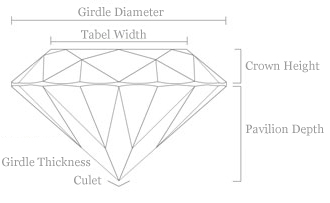
Diamond Anatomy
While every diamond is unique, all diamonds share certain structural features. A diamond’s anatomy, or its basic structure, determines its proportions, brilliance, dispersion and scintillation. Each part of the diamond has a specific name, and having a basic understanding of how each part contributes to the diamond as a whole will help you find your perfect diamond.
A diamond is comprised of the eight main components. They are Diameter, Table, Crown, Table Spread, Girdle, Pavilion, Depth, and Culet. Below is a brief description of each part of a diamond and its location.
- Diameter: The width of a polished stone, measured from edge to edge.
- Table: The largest polished facet located on the top of the diamond.
- Crown: The top part of a diamond extending from the table to the girdle. The crown is made up of bezel facets (crown mains), star facets, upper girdle facets (upper halves), and a table facet.
- Girdle: The very edge (widest edge) of the diamond where the crown and pavilion meet.
- Pavilion: The bottom part of a diamond extending from the girdle down to the culet.
- Depth: The total height of a diamond measured from the table to the culet.
- Culet: The small or pointed facet at the very bottom of the diamond.
Before purchasing a diamond, make sure that you have a basic understanding of a diamond’s anatomy. This will allow you to truly appreciate diamonds and all their intricacies, communicate with experts about a particular diamond, and, most importantly, it will assist you in making a well-thought out decision about which diamond is best for you.
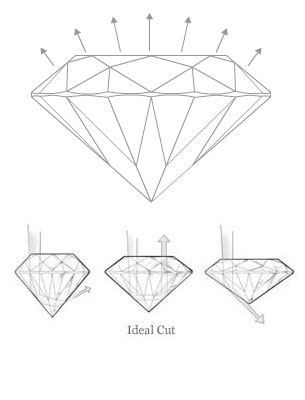
Ideal Cut Diamonds
An ideal cut diamond is a round, brilliant, or princess cut diamond that is cut to ideal proportions and angles and has excellent polish and symmetry ratings. An ideal cut diamond reflects almost all the light that enters it, and is among the rarest cuts. The ideal cut diamond is used as benchmark for grading all other diamonds. In America, ideal cut proportions are often determined by the American Gem Society Laboratory (AGSL), but different countries and different companies base their idea of the ideal cut on different standards.
Back in the 1900s, Belgian diamond cutter, Marcel Tolkowsky, coined the term- Ideal Cut. After analyzing the round brilliant cut diamond, he took both brilliance (the amount of the white light reflected) and fire (the separation of white light into its spectral colors) into consideration. While his calculations serve as a guide for today's idea of the global "ideal cut" standards, countries have still made their own modifications.
Tolkowsky's ideal cut is not perfect, but it nevertheless serves as a basic guideline for ideal cut diamonds. Today, we also use the guidelines of a gemstone cutter named Bruce Harding who developed another model in the 1970s as well as other computer models and technological scopes.
Ideal diamonds are perfectly proportioned to refract light, producing that fire and brilliance up through to the table and crown. There are at least six "ideal cuts" being used today but only three of them (including the one by Tolkowsky ) are the most common. James Allen, the premier diamond retailer, offers four cuts of diamonds, two of which are ideal. A TrueHearts diamond is a type of ideal cut diamond.
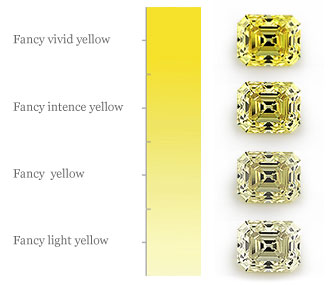
Color & Intensity
There are three different criteria used to determine a fancy color diamond’s color and intensity:
- The diamond’s primary color (i.e. pink)
- The diamond’s secondary color (i.e. purplish)
- The intensity of the diamond’s color (i.e. fancy, fancy intense, fancy vivid)
The primary and secondary colors determine the tone of the diamond’s color. The strength of the color is defined by its level of intensity. As a general rule of thumb, a fancy color diamond becomes more valuable as the color intensity increases. The classifications for fancy color diamonds are as follows: faint, very light, light, fancy light, fancy, fancy intense, fancy vivid/fancy deep/fancy dark.
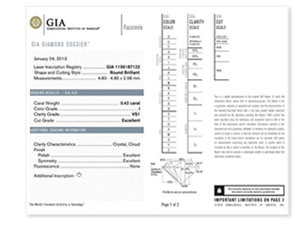
What is a Diamond Certificate?
A diamond certificate verifies each diamond’s specifications, including its color grade, carat weight, clarity grade and cut grade. You should never buy a diamond without a diamond certificate. The most well-known grading laboratories are the Gemological Institute of America (GIA) and the American Gem Society (AGS) and the International Gemological Institute (IGI).
A diamond's cost depends upon objective characteristics popularly known as the 4C's: Color, Clarity, Cut and Carat. The relationship between these four characteristics determines the value of a diamond. Although it is commonly assumed that carat is the most important member of the 4C's, color, cut and clarity have a much greater impact on the appearance of a diamond.
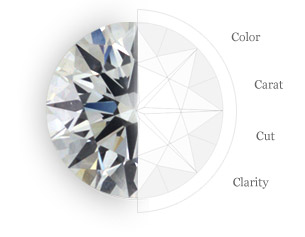
How to Choose the Perfect Diamond
When looking to buy a wedding or engagement ring, it is important that you know how to choose the perfect diamond. While some people prefer gemstone or rough diamonds, classic diamonds are still the most popular stone on the market and so it is essential that you understand everything you can about them. When searching for the perfect diamond*, there are four categories (or characteristics) to consider.
The 4 C's:
Cut - Describes the finish, proportion and polish of the diamond. These factors determine the fire and brilliance of a diamond.
An Ideal Cut diamond is a round (also known as brilliant) or princess cut diamond that is cut to ideal proportions and angles and has excellent polish and symmetry ratings.
A True Hearts diamond is a round or princess cut diamond that exhibits a near flawless Hearts and Arrows pattern of perfect optical symmetry, maximizing the diamond’s fire, brilliance and light dispersion.
Clarity - Describes the clearness or purity of a diamond. A grade is assigned to each diamond, with "F" representing a flawless diamond to "I" describing a diamond that has inclusions. Most diamonds can be found at various grades between “F” and “I.” Diamond buyers will sometimes choose a gem with some inclusions, as long as they are not visible to the naked eye.
Color - From white to yellow, diamonds receive a grade for the amount of color they contain. Diamond buyers prefer colorless to near colorless diamonds, with diamonds graded J, K, and L offering the best value for a customer’s money.
Carat - Carat refers to the weight of the diamond. One carat is equivalent to 0.20 grams. The larger the carat, the pricier the diamond, although the other "C's" can influence the final price significantly.
Though not mentioned as one of the four C's, a diamond's shape plays an integral part in the selection of any diamond engagement ring. James Allen offers diamonds in a variety of shapes, including: round, princess, emerald, square (asscher), oval, radiant, pear, heart, marquise and cushion shaped.
Lastly it is critical that you have a comprehensive understanding of diamond anatomy and proportion— brilliance, dispersion and scintillation.
Understanding how to choose the perfect diamond, will affect how you choose your engagement ring. Before choosing your perfect engagement ring, make sure you have a comprehensive understanding of diamonds- from their structure to the 4C's.
*To clarify, when we say perfect we are referring to the perfect diamond for you. This of course means that the diamond has the characteristics you desire and is within your budget. For example, some customers prefer larger diamonds with lower grades, while others prefer smaller diamonds with higher grades. Perfect diamonds— or diamonds without any flaws— are exceedingly rare and very expensive.

Diamond Care
Cleaning Your Diamond Jewelry
Depending on the setting you choose, you can soak your diamond engagement and/or wedding rings for up to 30 minutes in a solution of dishwashing liquid and water. This is best suited to prong and cathedral settings. In pave and basket settings, however, soaking the rings can increase the likelihood of the gems coming loose. Be mindful of this when you decide to soak any jewelry piece use mild dish soap in warm water and soak your jewelry for a few minutes. Using a soft cloth or cotton swab, gently scrub the metal (gold, platinum, silver) and then rinse. Repeat the process if necessary, but always proceed with caution when it comes to soaking jewelry.
For extra shine, you can soak diamonds in window cleaner afterwards. Because glass cleaner contains some harsh chemicals, do not soak for more than a minute at a time, and do not use this process at all with rhodium. To ensure that all of the glass cleaner is rinsed off, use the same mild dish soap solution. Dip your ring into the solution, rinse it with warm water, and then dry it completely.
You can use toothpicks to remove dirt that is lodged in between the prongs and the diamonds, but be extra careful not to scratch the metal or move the positioning of a prong. If fibers from cloth get stuck in the setting, gently use tweezers to remove them. Again, be careful of the metal. Even though diamonds can only be scratched by other diamonds, the precious metals into which they are set can be scratched more easily.
Ionic cleaners can be used on most diamond jewelry. If your engagement ring is set with stones other than diamonds, consider other cleaning methods, as some gemstones are adversely affected by the electrical current in the ionic cleaning process.
When storing your diamond jewelry, be sure to keep it separate from other jewelry. Remember that diamonds can not only scratch any other jewelry you have, but can scratch each other as well. Make sure that two diamond pieces are not being stored in such a way that they touch each other.
Insuring Your Diamond Jewelry
Once you have purchased your beautiful diamond jewelry, you will want to make sure that it is properly insured, in the event of theft or loss. Although homeowner's and renter's policies will cover a portion of your jewelry loss, it is often a small amount in comparison to the original cost of a diamond engagement ring or wedding ring. It is advisable to find out how much is covered by the policies you have in place, and then look into additional policies.
If you choose to get additional insurance, find out if there is a deductible and how much it is. Most insurance companies will not insure fine jewelry without an appraisal, so make sure you find out which appraisal reports are acceptable to your insurance company. Ask if the policy covers you fully, whether the item is merely damaged, or even if it is lost overseas. Many policies will have riders that do not allow for this level of coverage. Make sure you read the details of the policy carefully before you pay for extra insurance. Also find out if your jewelry is covered at the full replacement cost, and if you can receive a cash settlement in lieu of a replacement item.
Be aware that your insurance company may require updated appraisals on a regular basis. Be prepared to have your jewelry appraised every few years. Ask what the rules are for the particular insurance company you choose. Also find out if there is a discount if you have a home security system, such as an alarm system.
When you invest in diamond jewelry, you want to make sure that your investment is protected. Research insurance companies online or call around for information to make comparisons before you choose.






